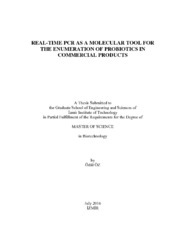Please use this identifier to cite or link to this item:
https://hdl.handle.net/11147/2840| Title: | Real-time PCR as a molecular tool for the enumeration of probiotics in commercial products | Other Titles: | Ticari ürünlerdeki probiyotiklerin sayımı için moleküler bir araç olarak gerçek zamanlı PCR | Authors: | Öz, Ödül | Advisors: | Baysal, Ayşe Handan Arslanoğlu, Alper |
Keywords: | Quantitative Real-Time PCR qPCR FTIR Bifidobacterium Lactobacillus Commercial probiotics 16S rDNA |
Publisher: | Izmir Institute of Technology | Source: | Öz, Ö. (2016). Real-time PCR as a molecular tool for the enumeration of probiotics in commercial products. Unpublished master's thesis, İzmir Institute of Technology, İzmir, Turkey | Abstract: | Quantitative Real-Time PCR (qPCR) assays targeting the 16S rDNA was developed as a genus and species specific detection tool for Bifidobacterium and Lactobacillus, and Bifidobacterium animalis subsp. lactis BB-12 and Lactobacillus acidophilus LA-5, respectively. Standard curves were established to quantify these probiotic bacteria. The linear regression of standard curves indicated high correlations between the log numbers of pure probiotic culture cells and the Ct values. The assay had a high efficiency and the limit of detection was estimated to be 1.54 ng DNA (corresponding to 104 cells). Results show that qPCR method may be very useful as a rapid, sensitive and specific tool for detecting and quantifying B. animalis subsp. lactis BB-12 and L. acidophilus LA-5 in probiotic supplements. FTIR spectroscopy was used for the first time to determine the ratios of different microorganisms in commercial probiotic supplements. FTIR analysis was also performed for the pure probiotic cultures of B. animalis subsp. lactis BB-12 and L. acidophilus LA-5. Results obtained in this study showed that FTIR spectroscopy is potentially a rapid method for determining probiotic cell components and their ratios in the supplements and verification their detection and identification. 16S rDNA’yı hedefleyen Kantitatif Real-Time PCR (qPCR) analizleri sırasıyla Bifidobacterium, Lactobacillus ve Bifidobacterium animalis subsp. lactis BB-12, Lactobacillus acidophilus LA-5 cins ve tür spesifik saptama aracı olarak geliştirilmiştir. Standart eğriler bu probiyotik bakterilerin sayısını ölçmek için oluşturuldu. Standart eğrilerin lineer regresyonu probiyotik kültür hücrelerinin log sayılarıyla Ct değerleri arasında yüksek korelasyon göstermektedir. Analiz yüksek verimlidir ve saptama limiti 1,54 ng DNA (104 hücreye karşılık gelen DNA miktarı) olarak tahmin edilmiştir. Sonuçlar qPCR yönteminin B. animalis subsp. lactis BB-12 ve L. acidophilus LA-5 probiyotik takviyelerinin saptanması ve miktarının belirlenmesi için hızlı, duyarlı ve spesifik bir araç olarak çok yararlı olabileceğini göstermektedir. FTIR spektroskopisi ticari probiyotik ürünlerdeki farklı mikroorganizmaların oranlarını belirlemek için ilk defa kullanılmıştır. FTIR analizi ayrıca B. animalis subsp lactis BB-12 ve L acidophilus LA-5 saf probiyotik kültürler için yapılmıştır. Bu çalışmada elde edilen sonuçlar, FTIR spektroskopisinin probiyotiklerin hücre bileşenleri ve bu bileşenlerin oranlarının belirlenmesinde ve ayrıca saptanması ve tanımlamasında hızlı bir yöntem olarak potansiyeli olduğunu göstermiştir. |
Description: | Thesis (Master)--Izmir Institute of Technology, Biotechnology, Izmir, 2016 Includes bibliographical references (leaves: 57-64) Text in English; Abstract: Turkish and English xiii, 71 leaves |
URI: | http://hdl.handle.net/11147/2840 |
| Appears in Collections: | Master Degree / Yüksek Lisans Tezleri |
Files in This Item:
| File | Description | Size | Format | |
|---|---|---|---|---|
| T001474.pdf | MasterThesis | 2.65 MB | Adobe PDF |  View/Open |
CORE Recommender
Page view(s)
148
checked on Jul 22, 2024
Download(s)
328
checked on Jul 22, 2024
Google ScholarTM
Check
Items in GCRIS Repository are protected by copyright, with all rights reserved, unless otherwise indicated.